Companies are reassessing where to invest within the Asia-Pacific region as market conditions evolve. When American and European companies first approached market expansion into emerging Asia, large markets like China and India became their natural choices. However, with rising business costs and increasing regulatory complexity, many of the strategic advantages of these larger economies are no longer as attractive today as they once were. More and more companies are looking beyond China and India to explore emerging opportunities in the Association of Southeast Asian Nations (ASEAN).
An effective prioritization strategy within Southeast Asia will be crucial for business investors given the region’s geographical fragmentation. Companies that understand the markets on a province/state level and invest selectively in the right subnational markets will have the best chances of success.
Why ASEAN for Multinationals?
For starters, rising consumption power and rapidly expanding manufacturing capacity are making ASEAN markets increasingly attractive investment destinations for multinational companies. Singapore serves as a good regional strategic hub for innovation and logistics, but the vast majority of ASEAN’s business potential is in what Frontier Strategy Group defines as “the emerging ASEAN-5” — Indonesia, Malaysia, Thailand, the Philippines and Vietnam. These markets represent some of the greatest opportunities for companies looking to expand their footprint in Southeast Asia. Companies are experiencing continued confidence in ASEAN’s growth and profitability outlook.
In the most recent ASEAN Business Outlook Survey from The American Chamber of Commerce in Singapore and the U.S. Chamber of Commerce, more than 85 percent of the 591 APAC executives expect to increase investment in the region for the next five years. Most emerging ASEAN-5 markets have experienced significant improvement in their business environments. The higher levels of ease of doing business will continue to attract investments from foreign companies. Emerging Southeast Asia also has massive potential to follow China’s digital development footprint in terms of e-commerce and a cashless society. The pro-innovation environment is likely to facilitate technological advancement and foster the growth of digital-savvy consumer and partner groups, further reducing multinationals’ sales and logistics costs via online channels.
Southeast Asia’s consumption power will experience rapid growth across all five major ASEAN markets in the next five to 10 years, offering an increasingly large consumer base for multinationals to tap into. Additionally, local manufacturing has become a critical consideration for companies to localize product development with the vast raw industry materials and low wages in the region — especially compared to markets like China where soaring costs of production have begun to threaten business bottom lines.
Given the immense potential of the ASEAN-5, the question executives will have is, “Where should we start first?” With the high concentration of economic activity in a relatively small number of provinces or states, the answer is not simply a country like Indonesia or Vietnam. Companies should not only compare ASEAN markets from a national perspective; evaluations on a subnational level are critical as well.
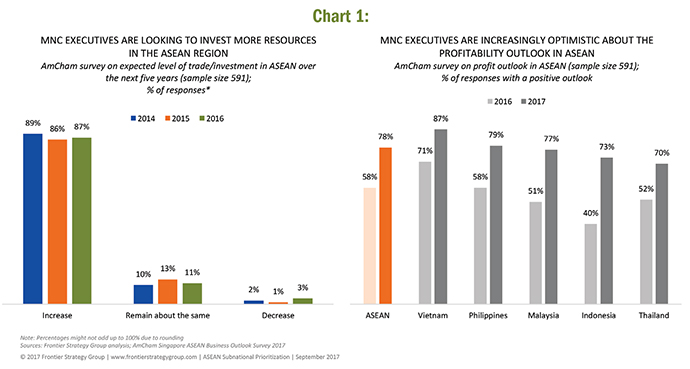
Country-level Analysis Is Not Enough
The ASEAN region presents a balanced opportunity for MNCs in terms of market size and growth potential. For investors that are more careful or even risk-averse, the markets’ varying economic growth drivers also offer diversified investment portfolio options.
However, the region’s fragmented market landscape and complex business environments pose challenges for multinationals to prioritize investments effectively. Few companies understand the emerging ASEAN-5 markets thoroughly enough on a subnational level to optimize demand-side opportunity and supply-side support. MNC executives could end up with a lower-than-anticipated ROI if investments are diluted across all subnational markets, given the region’s geographical complexity and market fragmentation. Why is country-level resource allocation insufficient for MNCs investing in the region?
- Of the 205 subnational markets in the ASEAN-5, the largest 20 account for 60 percent of the region’s total GDP;
- ASEAN’s wealth is highly concentrated: 11 major provinces or states hold 60 percent of the region’s consumption power;
- ASEAN’s manufacturing capacity is heavily clustered: 14 subnational markets take up 57 percent of the region’s manufacturing output.
Because ASEAN’s consumption power and manufacturing capacity tend to be concentrated in a few major subnational regions, companies can effectively get ahead of competition by conducting a province/state-level prioritization exercise. This will help differentiate their local go-to-market plans on the most competitive subnational markets, and successfully drive upward and downward alignment on strategic goals.
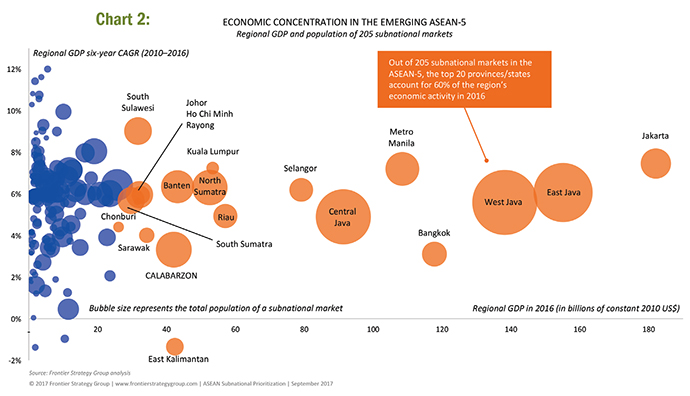
How to Design a Subnational Market Prioritization Strategy
Frontier Strategy Group’s prioritization framework helps companies identify risk-adjusted opportunity and evaluate operating environments across 205 ASEAN-5 subnational markets, allowing for more effective, data-driven resource allocation. It can be applied to both business-to-consumer companies (B2C) and business-to-business (B2B) companies.
By measuring investment opportunity in each subnational region based on market size, growth potential, presence of industry clusters and market stability, MNCs can create a more targeted approach in prioritizing markets across the ASEAN-5. It is critically important also to assess infrastructure quality, availability of talent, access to finance and tax burden, all of which are essential operating environment factors for assessing subnational markets in Southeast Asia.
Here is a three-step process for building a successful subnational prioritization plan for the emerging ASEAN-5 region:
Step 1: Measure Risk-adjusted Opportunity
First, companies should measure the overall market opportunity of each province and state by analyzing leading indicators of size, growth, industry clusters and market stability. The following chart offers an illustrative example of a risk-adjusted opportunity evaluation:
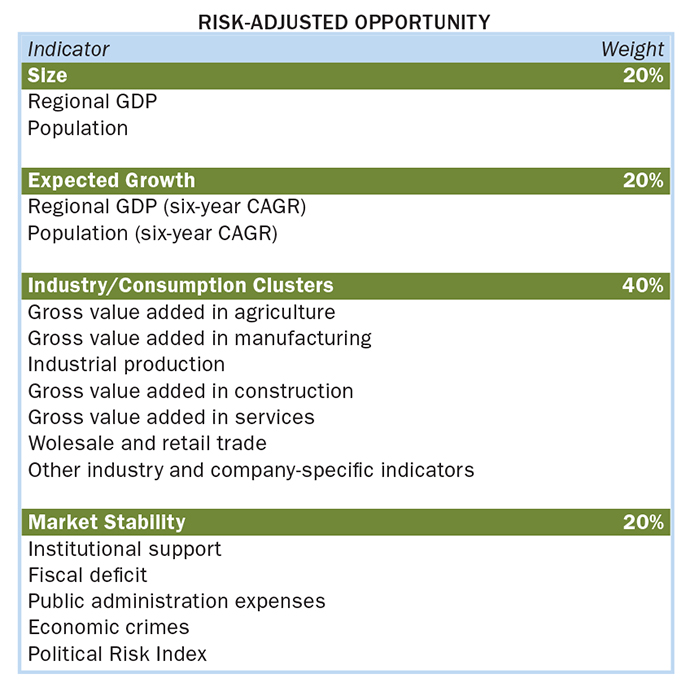
Step 2: Assess Operating Environments
Companies should measure the operating environment of each province and state by analyzing indicators related to infrastructure, availability of talent, access to finance and business & tax environment. As province/state-level data for ASEAN is very limited and is often difficult to benchmark across countries, MNCs will need to combine national and subnational analyses to build a balanced model to evaluate opportunities and risks. The following chart offers an illustrative example of the operating environment analysis:
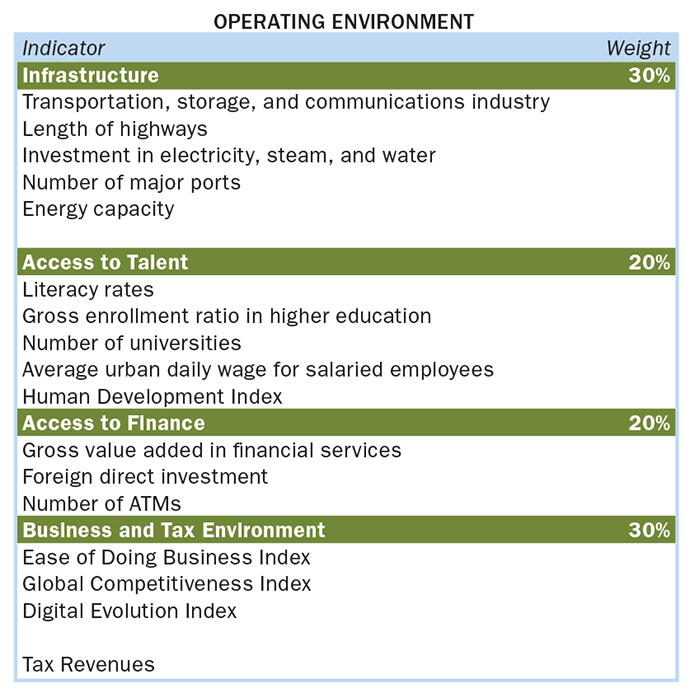
Step 3: Evaluate Results
To leverage the market evaluation results for strategic investment, companies should begin by categorizing markets into three tiers based on risk-adjusted opportunity. Tier 1 markets are the must-have markets; Tier 2 markets are for selective investment; Tier 3 markets are mostly deprioritized for long-term opportunity. By breaking down subnational markets into three groups, companies can better understand which geographies should be a business priority today versus tomorrow. See Step 3-A for a sample three-tier categorization.
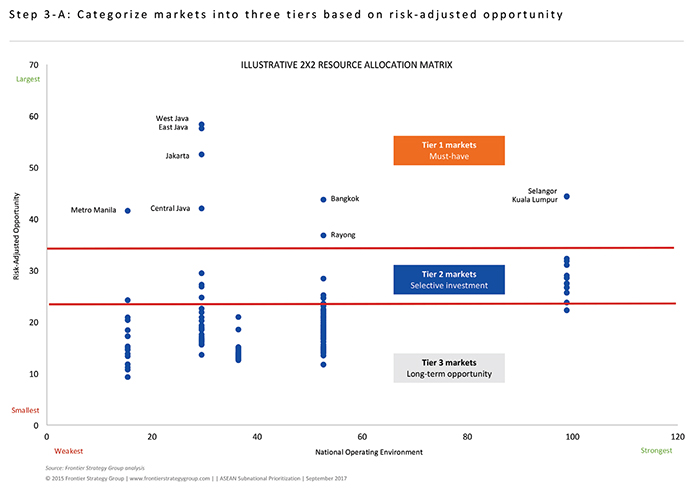
After categorizing markets by tiers, companies should then further assess business clusters based on operating environment and geographical ease of access. Due to ASEAN’s maritime geography and market fragmentation, companies will need to map out top-tier markets to determine more attractive provinces/states, which is of significant importance when sales resources are limited and investment tradeoffs have to be made among Tier 2 options. MNCs will find it much easier to access Tier 2 markets that are located closer to Tier 1 markets geographically to capture economies of scale in customer segmentation, product localization and sales channel efficiency. See Step 3-B for an illustrative mapping of priority markets.
Let’s take the example of a consumer goods company manufacturing locally in Southeast Asia. From the Tier 1 markets identified in the example above, we can see that for a retail company seeking to capitalize on ASEAN’s growing market demand and local manufacturing capacity, states in West Malaysia and provinces on the Java island have been strong in consumption power and are critical industry clusters to invest in. In Thailand, consumption power is mainly clustered around Bangkok, Rayong and their adjacent provinces, as well as the more tourism-focused southern provinces (e.g., Phuket and Krabi), while in the Philippines, the Metro Manila area (NCR) is a highly concentrated market for B2C demand. In addition, even though Ho Chi Minh and Hanoi in Vietnam are relatively small in economic size, MNCs may need to evaluate them for industry specialization or investment diversification.
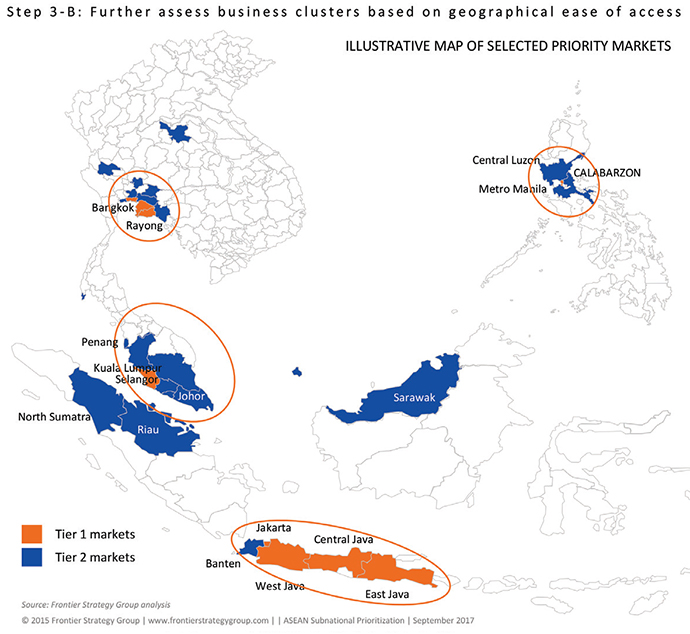
To conduct a comprehensive province/state-level portfolio allocation analysis in ASEAN and determine the optimal business fit levels, MNC executives will find it useful to incorporate more industry-specific data to examine industry landscape and internal capabilities as well.
While MNCs may continue to give China and India large amounts of attention in the Asia-Pacific region, many stakeholders realize the increasingly attractive profitability outlook that Southeast Asia offers. For forward-thinking companies, the time is now to assess mid-term market opportunity in ASEAN. Multinational executives who proactively manage the ASEAN market prioritization process, especially on a province/state-level, will be able to avoid an opportunistic stance to investing in ASEAN and fully capitalize on the region’s market potential in this new era of doing business in the Asia-Pacific region.

Danyi Yang is Practice Leader, Asia Pacific, at Frontier Strategy Group, a Washington, D.C.-based information and advisory services firm. For more information, visit www.frontierstrategygroup.com.
